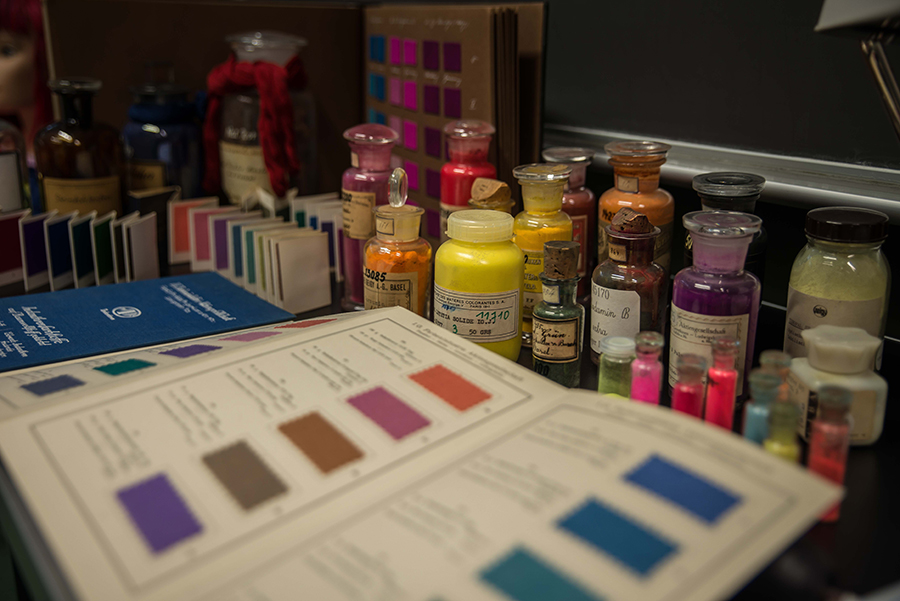Prof. Buether, there were times when the scientific study of colors occupied the great scholars: when Newton used lenses to break light down into individual colors and then reassemble it back to its initial colorlessness, this inspired Goethe to develop color theory – why is this still an important research topic today?
Axel Buether: This interplay between the natural sciences and the humanities is even older. It was Newton who made the problem one of physics and optics. Goethe looked at it more psychologically. With his sensual and moral theory of color, he created the basis for the psychology of color, which is still of interest to us today. And even today, color still occupies all scientific fields from chemistry, biology and physics to philosophy and the psychology of perception. Goethe was absolutely right about the latter. Color has meaning for all perspectives of being human. It makes the world tangible and accessible. We therefore track it down using empirical science, but also through introspective observation. An eternal problem to this day is the question of whether colors are secondary or primary properties of the environment.
Natural science tells us that matter and energy are primary properties of the environment – and colors are rather only wavelengths occurring in the brain. What is important, however, is that color is a central medium for understanding, perceiving and creating. It therefore has the same meaning as language. In other words, color is a culturally developed visual language. This means that we no longer just inhabit the world like animals and plants, but also shape our cultural space through visual sign systems. It is not tactile shapes, but the color coding that can be seen from a great distance that provides orientation in the urban space. Shapes of the same color merge before our eyes into indefinable masses. Bodies only stand out against their background and convey meaning to us when they contrast in color: Do we have a building, an entrance in front of us? Is it a public or private building? What is initially only a colour signal on the retina is organized into shapes and movements, into symbols that we only perceive through color. So color vision is more important to us than touching, smelling or licking. Goethe was a pioneer in understanding the great importance of color for our perception – the psychological aspect of his theory of color is his legacy.
Today, more than 300 years after Newton’s prism experiments, which seemed like pure light torture to Goethe, we are less squeamish. We use modern scientific methods, e.g. neuroscientific methods. How and what are we actually researching today with these means?
Axel Buether:
The systematic approach to color perception began with a certain understanding of light. Initially, there was the idea that we had an image of nature on our retina – this has been refuted. Our eyes have a very small center, the fovea centralis, which is structured like a funnel. This is where the photoreceptors are concentrated, in particular all the color cones, of which there are three types – sensitive to red, green and blue. And we see the world with these color cones lying alone in the center. The eyes move all the time. And within just 2 degrees of this field of vision, we can see sharply and in full color. The field of vision covers a total of 180 degrees – but we can rotate our neck by 45 degrees. We can consciously perceive 60 degrees. We perceive the periphery unconsciously and emotionally. But if we want to see something there, we have to turn around. In other words, we only see what interests us – and this is where colors become important. One of the results of recent research shows just how important they are: Tracking data streams in the brain shows that 60% of the brain is used for processing color signals.
What does this actually mean for colorblind people?
Axel Buether:
People who are colorblind don’t see nothing, they just have an image with less information. To understand: We have 6 million cones and 120 million rods in the retina. Some people still deduce from this that the latter are more important. They are sensitive to light – but hardly important during the day, only at dusk and at night do they provide shades of gray. During the day we only use the cones, the rods are hardly active. Pure “black and white” images belong to the phases of twilight and night, whereas daytime images are composed of many millions of shades of color. We see white and gray when all three cone types are equally excited, which is why we always perceive colored shades of white and gray during the day. The impression of black is created by the absence of light or the lack of activity in the retina of our eyes. Bodies that completely absorb light appear black to us. Most black tones are created by strong contrasts in brightness, especially in the shadow zones of bodies and rooms. The cones of the colorblind person cannot receive or process color signals. The colorless room loses much of its depth, resolution and richness of detail. When calculating the ratio of the wavelengths red (long), green (medium) and blue (short), an exponentially increased spatial resolution is achieved, as each pixel point in the image can be distinguished not only by brightness gradations, but also by chromatic colors. So much more information can be derived from the spectrum of sunlight or artificial light – that is the color. Without colors, we would find it more difficult to orient ourselves, objects are less distinguishable from one another – and the possibilities for visual communication, for conveying thoughts and emotions and identity are also significantly reduced. That’s what color is for: orientation, identity, recognizing meanings and emotions, feeling comfortable in the world.
So the role of color in interior design cannot be overestimated?
Axel Buether: Our entire vision with the help of the 6 million cones is based on a mixture of chromatic colors and shades of gray in hundreds of thousands of nuances. This does indeed have consequences for the design of our environment. Even the restriction to pure white often observed among architects does not avoid the confrontation with color. This is because there are many cold to warm shades of white that differ considerably from one another. In an experiment, we once distinguished between 60 different shades of white. Color quality is determined by the amount of color, and the gloss, depth, intensity and structure of the color also play a far greater role than previously assumed. There are always color nuances – and you have to deal with them when designing a room. This applies to all colors and light sources to be purchased. Wall color and lighting together have an effect on people’s heat balance and can cause a feeling of well-being or even a chill in the room. These differences can be up to 4 degrees Celsius. Warm colors and warm lighting can therefore easily contribute to savings on heating costs.
What else has been discovered recently thanks to neuroscientific research?
Axel Buether: It is important to realize that color is not just a visual medium, but has a direct and involuntary effect on the body. For example, it changes our metabolic processes and our hormones. This is already plausible from the observation that when it is cloudy in the morning, we don’t get going and lack motivation. This is why we should also plan daily walks in the darker months of the year. Even in winter, the light outside is several thousand times stronger than inside. We need sunlight for motivation, for our metabolism and for our appetite. Wherever we are active, wherever we eat and wherever interpersonal communication is involved, we should use direct sunlight or artificial light with a sun-like, i.e. full-color spectrum. Sunlight motivates our urge to act. Too little daylight, as well as artificial light with a reduced color spectrum, reduces our motivation, inhibits important bodily functions and activities, promotes negative moods or even depression. Color and light have an involuntary, automatic and unconscious effect on our physical state – we just have to create the conditions for it.
… especially in nursing homes?
Axel Buether: In care homes, we can ensure that we get much more out of our twilight years and live longer and healthier lives. When planning the nursing home, you should differentiate between color and lighting design according to the specific use of the room – the briefing in advance is very important here. Sport, eating, working and communicating need brightness. Retreat and coziness require different colored light. So it’s not enough to simply make everything “bright and friendly” – we also need cooler or darker zones.
Light and color are two sides of the same coin, so to speak, you write in your book “Farbe. Design principles, planning strategies, visual communication”. What is the relationship between the two – and what can this mean in practical terms for the designer?
Axel Buether: The light source – be it the sun or an artificial source – emits light that reaches us directly or as ambient light. Some of the radiation falls directly on our eyes – and there is radiation that falls from the source onto surfaces and is partly absorbed and partly reflected. Now the brain comes into play and the effect of so-called color constancy: A white balance is made – the color is calculated from the white of the light source. In this way, body color is created via the surfaces in the surroundings, and light color is created via the light falling directly on the eye. The colors are now created by converting part of them into heat – black does not absorb light. And in the case of chromatic colors, part of the spectrum is absorbed and green, red and blue are absorbed in a certain ratio and converted into heat. This is how plants turn green, for example: The short- and long-wave light is needed, the medium-wave light is not needed and is reflected, which makes plants appear green to us. So we see the spectrum of light energy, which the plant cannot utilize. If I now change the quality of the light, the quality of the body colors also changes automatically: All the colors in the room change. Warm white light sources shift the colors into the reddish range. With neon cold or energy-saving lights, the colors shift into the blue, cool range. Light and color must therefore always be seen together. They really are two sides of the same coin – or to put it another way: Color shines, and light colors.
Mr. Buether, let’s talk a little more about the significance of colors or certain color combinations for us personally. We obviously carry something like a color origin with us. So do we inherit color perception like bald heads and moles? And how does this color origin manifest itself – what does it change about the effect of colors?
Axel Buether: Everyone has a color home. The background to this is certainly genetic predisposition – however, the actual meaning of colors for us, whether colors make us feel good or unwell, has more to do with our personal experience. The colors of our childhood, the region we come from, the nature associated with it, for example. It makes a difference whether we come from a valley with long winters, for example, or whether we grew up in the city or by the sea. This results in certain needs, a certain leisure behavior. The associated lighting moods are also preferred later on. We call these personal needs color preferences. They are reflected in our clothing, our everyday objects, our living and working environments. If we are torn away from our traditional color home in old age, for example by moving from our private home to a retirement or nursing home, we feel alienated and uncomfortable, are more prone to depression and are less able to counter illnesses. The orientation of the color design to the color preferences of the target group, which includes the selection of all materials as well as the planning of lighting with natural and artificial light, is therefore a central task of architecture and interior design.
This speaks in favor of a regionally oriented design of care and senior citizen facilities …
Axel Buether: Yes. It makes a difference whether a nursing home is located in Hamburg or Munich. Here, too, it is important to check who is to use the rooms, where they come from and what their color home looks like. This is particularly important where senior citizens move into fully furnished rooms that cannot be easily adapted. Even if the residents come from different areas, it is important to take these connections into account. This does not mean remaining stuck in folklore. The task for progressive architecture here is to recognize the colour preferences and colour home of the target group and, on this basis, to design a contemporary environment in which old and sick people can feel comfortable. There need be no contradiction between color home and modernity, as many highly praised and often published buildings prove, in which the “creation of atmospheres” is the focus. Traditional materials such as wood, natural stone, textiles or mineral colors can be used in new ways. The use of new materials can be used to further develop traditional color languages. The home of color is the starting point – the contemporary approach to it is the challenge.
Link to the second part of the interview
[download id=”50″]



